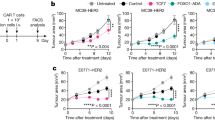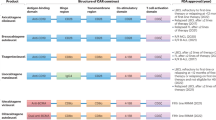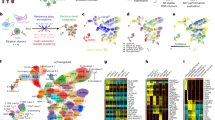Abstract
Treatment of chronic myeloid leukemia (CML) with the tyrosine kinase inhibitor imatinib represents a successful application of molecularly targeted cancer therapy. A rapid hematologic and cytogenetic response can be induced in the majority of people, even in advanced disease. However, complete eradication of malignant cells, which are characterized by the expression of the BCR-ABL1 fusion protein, is rare. Reasons for the persistence of the malignant clone are currently not known and provide a substantial challenge for clinicians and biologists. Based on a mathematical modeling approach that quantitatively explains a broad range of phenomena, we show for two independent datasets that clinically observed BCR-ABL1 transcript dynamics during imatinib treatment of CML can consistently be explained by a selective functional effect of imatinib on proliferative leukemia stem cells. Our results suggest the general potential of imatinib to induce a complete elimination of the malignant clone. Moreover, we predict that the therapeutic benefit of imatinib can, under certain circumstances, be accelerated by combination with proliferation-stimulating treatment strategies.
This is a preview of subscription content, access via your institution
Access options
Subscribe to this journal
Receive 12 print issues and online access
$209.00 per year
only $17.42 per issue
Buy this article
- Purchase on Springer Link
- Instant access to full article PDF
Prices may be subject to local taxes which are calculated during checkout



Similar content being viewed by others
References
Eaves, C., Udomsakdi, C., Cashman, J., Barnett, M. & Eaves, A. The biology of normal and neoplastic stem cells in CML. Leuk. Lymphoma 11 (Suppl. 1), 245–253 (1993).
Deininger, M.W., Goldman, J.M. & Melo, J.V. The molecular biology of chronic myeloid leukemia. Blood 96, 3343–3356 (2000).
Mauro, M.J. & Druker, B.J. Chronic myelogenous leukemia. Curr. Opin. Oncol. 13, 3–7 (2001).
Marley, S.B., Deininger, M.W., Davidson, R.J., Goldman, J.M. & Gordon, M.Y. The tyrosine kinase inhibitor STI571, like interferon-α, preferentially reduces the capacity for amplification of granulocyte-macrophage progenitors from patients with chronic myeloid leukemia. Exp. Hematol. 28, 551–557 (2000).
Hehlmann, R., Hochhaus, A., Berger, U. & Reiter, A. Current trends in the management of chronic myelogenous leukemia. Ann. Hematol. 79, 345–354 (2000).
Cortes, J. et al. Molecular responses in patients with chronic myelogenous leukemia in chronic phase treated with imatinib mesylate. Clin. Cancer Res. 11, 3425–3432 (2005).
Druker, B.J. et al. Effects of a selective inhibitor of the Abl tyrosine kinase on the growth of Bcr-Abl positive cells. Nat. Med. 2, 561–566 (1996).
Holtz, M.S. et al. Imatinib mesylate (STI571) inhibits growth of primitive malignant progenitors in chronic myelogenous leukemia through reversal of abnormally increased proliferation. Blood 99, 3792–3800 (2002).
Oetzel, C. et al. The tyrosine kinase inhibitor CGP 57148 (STI 571) induces apoptosis in BCR-ABL-positive cells by down-regulating BCL-X. Clin. Cancer Res. 6, 1958–1968 (2000).
Vigneri, P. & Wang, J.Y. Induction of apoptosis in chronic myelogenous leukemia cells through nuclear entrapment of BCR-ABL tyrosine kinase. Nat. Med. 7, 228–234 (2001).
Topaly, J., Fruehauf, S., Ho, A.D. & Zeller, W.J. Rationale for combination therapy of chronic myelogenous leukemia with imatinib and irradiation or alkylating agents: implications for pretransplant conditioning. Br. J. Cancer 86, 1487–1493 (2002).
Michor, F. et al. Dynamics of chronic myeloid leukemia. Nature 435, 1267–1270 (2005).
Loeffler, M. & Roeder, I. Tissue stem cells: Definition, plasticity, heterogeneity, self-organization and models—A conceptual approach. Cells Tissues Organs 171, 8–26 (2002).
Roeder, I. & Loeffler, M. A novel dynamic model of hematopoietic stem cell organization based on the concept of within-tissue plasticity. Exp. Hematol. 30, 853–861 (2002).
Roeder, I. et al. Competitive clonal hematopoiesis in mouse chimeras explained by a stochastic model of stem cell organization. Blood 105, 609–616 (2005).
Ichimaru, M., Tomonaga, M., Amenomori, T. & Matsuo, T. Atomic bomb and leukemia. J. Radiat. Res. (Tokyo) 32 (Suppl. 2), 14–19 (1991).
O'Brien, S.G. et al. Imatinib compared with interferon and low-dose cytarabine for newly diagnosed chronic-phase chronic myeloid leukemia. N. Engl. J. Med. 348, 994–1004 (2003).
Müller, M.C. et al. Dynamics of BCR-ABL mRNA expression in first line therapy of chronic myelogenous leukemia patients with imatinib or interferon-α/ara-C. Leukemia 17, 2392–2400 (2003).
Jorgensen, H.G., Copland, M. & Holyoake, T.L. Granulocyte–colony-stimulating factor (Filgrastim) may overcome imatinib-induced neutropenia in patients with chronic-phase myelogenous leukemia. Cancer 103, 210–211 (2005).
Lahaye, T. et al. Response and resistance in 300 patients with BCR-ABL-positive leukemias treated with imatinib in a single center: a 4.5-year follow-up. Cancer 103, 1659–1669 (2005).
Hochhaus, A. & La Rosee, P. Imatinib therapy in chronic myelogenous leukemia: strategies to avoid and overcome resistance. Leukemia 18, 1321–1331 (2004).
Deininger, M.W. & Druker, B.J. SRCircumventing imatinib resistance. Cancer Cell 6, 108–110 (2004).
Graham, S.M. et al. Primitive, quiescent, Philadelphia-positive stem cells from patients with chronic myeloid leukemia are insensitive to STI571 in vitro. Blood 99, 319–325 (2002).
Catlin, S.N., Guttorp, P. & Abkowitz, J.L. The kinetics of clonal dominance in myeloproliferative disorders. Blood 106, 2688–2692 (2005).
Komarova, N.L. & Wodarz, D. Drug resistance in cancer: principles of emergence and prevention. Proc. Natl. Acad. Sci. USA 102, 9714–9719 (2005).
Emig, M. et al. Accurate and rapid analysis of residual disease in patients with CML using specific fluorescent hybridization probes for real time PCR. Leukemia 13, 1825–1832 (1999).
Acknowledgements
We thank the members of the German CML study group, coinvestigators, nursing and research staff for their collaboration and S. Fruehauf for critical reading of an earlier version of this manuscript. The modeling work (I.R., M.H., I.G. and M.L.) was partially supported by the Deutsche Forschungsgemeinschaft, grants LO-942/1-1, 2 and RO3500/1-1. Molecular and clinical studies (A.H. and M.C.M.) were supported by Novartis Pharma, the Competence Network 'Akute und chronische Leukämien' sponsored by the German Bundesministerium für Bildung und Forschung (Projektträger Gesundheitsforschung, DLR e.V. – 01 GI9980/6), and the European LeukemiaNet within the Sixth European Framework Program for Research and Technology Development.
Author information
Authors and Affiliations
Corresponding author
Ethics declarations
Competing interests
The authors declare no competing financial interests.
Supplementary information
Supplementary Fig. 1
Simulation of CML genesis. (PDF 134 kb)
Supplementary Fig. 2
Transition characteristics. (PDF 228 kb)
Supplementary Fig. 3
Individual subject data. (PDF 587 kb)
Supplementary Fig. 4
Model prediction for combination of imatinib with cytotoxic treatment. (PDF 190 kb)
Supplementary Fig. 5
Computer simulation of prolonged imatinib administration. (PDF 192 kb)
Supplementary Table 1
Model parameters for normal and leukemic cells. (PDF 56 kb)
Supplementary Table 2
Model parameters for treatment simulation. (PDF 50 kb)
Rights and permissions
About this article
Cite this article
Roeder, I., Horn, M., Glauche, I. et al. Dynamic modeling of imatinib-treated chronic myeloid leukemia: functional insights and clinical implications. Nat Med 12, 1181–1184 (2006). https://doi.org/10.1038/nm1487
Received:
Accepted:
Published:
Issue Date:
DOI: https://doi.org/10.1038/nm1487
This article is cited by
-
Acute interstitial pneumonia image enhancement using fuzzy partial transforms
Applied Geomatics (2024)
-
A mixed-effects stochastic model reveals clonal dominance in gene therapy safety studies
BMC Bioinformatics (2023)
-
The structure of the hematopoietic system can explain chronic myeloid leukemia progression
Scientific Reports (2023)
-
Understanding Hematopoietic Stem Cell Dynamics—Insights from Mathematical Modelling
Current Stem Cell Reports (2023)
-
Comparison between of fuzzy partial H-transform and fuzzy partial Laplace transform in x-ray images processing of acute interstitial pneumonia
International Journal of System Assurance Engineering and Management (2023)



